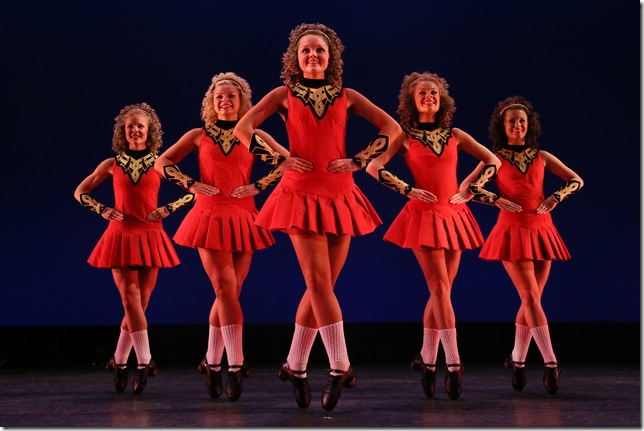By Tara Mitton Catao
Last Saturday night, the stage of the Kravis Center for the Performing Arts brimmed with the buoyant movement of the Trinity Irish Dance Company, reflecting not only a timeless appeal but a freshly invigorating approach.
The bouncing curls and lightning feet of the young dancers filled the performing space with what is now being called “progressive Irish step dancing.” Though there was lots of the lively, toe-tapping rhythms that made you want jump up and dance as well as the familiar traditional costumes, the program presented was far from what might come to mind when you think of Irish dancing.
The highly energized dancers wove together the new and old steps with unflagging stamina in a plethora of solo jigs and group céilí dances choreographed by founding Artistic Director Mark Howard, but the young dancers also pushed their artistic boundaries by performing in contemporary works created by various modern dance choreographers.
Starting with what initially seemed more like traditional works, you were soon being blasted with fast-paced in-your-face energy, rock-star lighting and full rev dances. Some of the works incorporated complex, stiff arm movements (traditionally arms are just kept down in Irish dancing) that seemed impossible to coordinate with the extremely quick and very intricate footwork that happened mostly from the knee down.
All this was done while the dancers backed up into perfect quadrille formations in perfect unison. It was impressive, but in the first half of the program, most of the works had a blaring quality with only one level of intensity. There was a sense of striving to be too sensational.
The performers used two types of dancing shoes — the soft shoes (ghillies) for the light jigs and hard shoes with fiberglass tips that enhanced the tapping sound as they utilized eight striking surfaces for the rhythms of the heavy jigs.
The dancers were clearly experts in percussion and in Black Rose, a work inspired by Japanese kodo drums, eight women added drumsticks to tap and beat rhythms while dancing with perfect clarity both physically and audibly.
There was also a host of wonderful musicians who took over the stage from time to time to sing and play the infectious tunes that reminded one of Ireland. At one point in the program, one of the talented fiddle players, the lovely Kathleen Grennan, put her fiddle aside and showed off her equally impressive dancing feet.
A welcome respite from the stream of intense high energy came right before intermission with Communion, a collaborative work by Howard and body percussionist Sandy Silva. Captivating, with its unusual and unexpected rhythms that faded in and out, the dance opened new horizons for the talents of the dancers. There were snaps, claps and even rustles and crunches which the dancers created while dancing. In the appealing sparseness of the work, one could hear what seemed like the beating of wings.
Beginning the second half of the program was a work in progress. Colin Dunne, one of the most famous Irish dancers, created a pared-down, carefully executed exploration of rhythm that incorporated using other parts of the body for additional percussion sounds. He called the work Listen.
Building slowly, a group of nine women dressed in gray and black rehearsal clothes walked in a circle introducing the step and sound vocabulary. Each layer was added with intent and focus. However, when the dancers began to introduce tap rhythms into floor microphones that reverberated the rhythms back, the work began to lose its momentum. Though the electronic interplay was an interesting concept, it needed further choreographic development.
Push, also choreographed by Howard, seemed to be a nod to the history of competitive dancing. TIDC is a natural culmination of Howard’s renowned dance school, The Trinity Academy of Irish Dance, which has been very successfully training dancers for competition for almost 30 years, many of whom have brought back world championship titles.
Push is deceptively simple but extremely effective. It was wonderful to watch with its elegant costumes — the men bare-legged in black tops and kilts and the the women covered in black tops and leggings. The competitive and challenging air between the dancers was lighthearted and fun as they sparred with their dazzling technique in a small area of the stage.
Push’s simplicity seemed reminiscent of the time when hard surfaces were difficult to come by in the countryside and Irish dancers would perform on unhinged doors so that their tapping intricacies could be heard. It is said that the restriction of the small performing area inhibited the dancers’ arm movements and drew more attention to their amazingly intricate footwork, thereby creating the trademark style of the craft: blazing feet and still arms.
Push was pure in its presentation and outstanding in its dancing. Maggie Doyle, MaryClaire McDonnell, Craig Ashurst and Peter Dziak were a thrill to observe as they vied with each other showing off their most impressive steps and most sophisticated rhythms.
According to Howard, the quest of Trinity Irish Dance Company is to be “progressive without losing touch with tradition and entertaining while putting a premium on integrity.”
Perhaps in the presentation Saturday night, there was too much of a dichotomy between the large, curly hairpieces, too-bright smiles in the traditionally costumed quadrille formations, and the introspective and engaging explorations into the beauty and complexities of rhythm in the contemporary works. But the program and mission of Trinity Irish Dance was most engaging and made me want to get up and learn to dance a jig myself.
